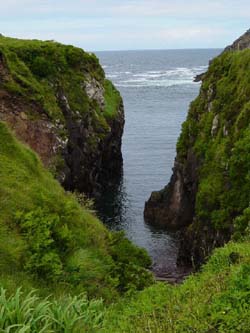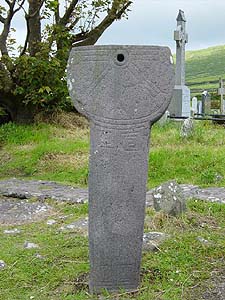Brendan the Navigator
and the Working Celtic Cross
|
Photographs by Maureen Palmer ©2002
This is the embarkation point of Saint Brendan the Navigator
when he set sail for America from Ireland over 1,400 years ago.
Far across the distant horizon, over mighty oceans lie the promised lands
Brendan the Navigator is a legend amongst the Irish and Celtic people for many reasons. There are many people throughout the world who would like to see more evidence that the transatlantic voyages of St Brendan could be more than just exaggerated stories.
The current academic position against such a voyage of discovery 900 years before Christopher Columbus rests solely of the presumption that St Brendan, like earlier potential transatlantic voyagers, had no knowledge of the fundamentals of navigation.
There can be little argument about the other side of the technology required, which is a substantial and seaworthy enough craft to make the voyage.
This point was proved when voyage in the footsteps of St Brendan, was made by Tim Severin in 1977. To fulfill the "The Brendan Voyage", Tim Severin successfully built a currach, faithful to the construction methods of 6th century shipwrights and sailed across the Atlantic proving that the journey could have been done in principle. So, there only remains the question of navigation, since motivation is clearly shown.
As far as this article is concerned, Crichton's intend to show, in combination with his earlier discovery that the Celtic cross was a working navigational instrument, that the legends of St Brendan crossing the Atlantic to America hold considerable potential for truth. That it is highly likely that St Brendan understood the cross and plumbline for its true value using it in combination with the more ancient knowledge of his own earlier ancestors. That this discovery was either esoteric in origin or that he discovered this knowledge from the prehistoric mounds at Ardfert .
Here is what Maureen Palmer has to say:
Ardfert cathedral is built on the earlier monastic site dedicated to St Brendan and is in the process of being restored, although not much is known about the earlier site only that over two thousand medieval burials were excavated and some of the burials had been aligned to an earlier structure.
Brendan was born in Ciarraighe Luachra, in County Kerry, Ireland in 484 AD and grew up by the sea and was a charismatic leader who gained many followers, this resulted in the founding of monastic communities along the West Coast of Ireland over a period of some 30 years.
What is not generally understood, is that in the days of St Brendan, there were very few roads.
This was in the early days of the conversion of "Pagans" to Christianity by the Holy Roman Empire. The lack of safe overland routes made traveling by land a very difficult and sometimes hazardous affair.
The way in which people traveled around and traded, in ancient times, was by sea.
That is why most major settlements were by river estuaries and still are to this day.
Evidence of this can be seen through the monastic sites that Brendan was associated with being located close to the River Shannon.
Brendan is known to have visited Iona in Scotland, France and Wales in his voyages.
He started Monasteries in Scotland in locations, by the water, near the sites of more ancient standing stones at Kilbrandon and Kilbrennan Sound.
Of his spiritual power and Missionary zeal, there can be no doubt.
This is shown by the expansion of religious houses to accommodate pilgrims throughout Ireland.
St Brendan the NavigatorÌs most celebrated foundation was Clonfert in County Galway. He died in 577 AD in sister BrigaÌs convent at Enachduin, now known as Annaghdown.His grave faces the front door of the Cathedral in Clonfert.
|


Other history related articles on this site:
.
.
.
.
.
.
.
.
.
.
.
.
If you have a suggestion or history related article to submit, send it to:
Editor/viewzone.com
myristicin@hotmail.com

 Ard Fertu means the height of the burial mounds.
Ard Fertu means the height of the burial mounds.